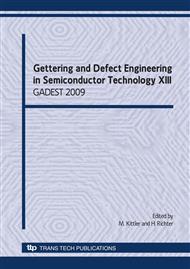p.299
p.305
p.313
p.319
p.325
p.331
p.337
p.343
p.351
Influence of Hydrogen on the Structural Stability of Annealed Ultrathin Si/Ge Amorphous Layers
Abstract:
The influence of hydrogen on the structural stability of multilayers made of ultrathin (3 nm) Si and Ge amorphous layers submitted to annealing to activate Si and Ge intermixing has been studied by TEM and AFM. By energy dispersive microanalysis the interdiffusion of Si and Ge has been observed. The Si/Ge multilayers, however, underwent remarkable structural degradation because of the formation of hydrogen bubbles which give rise to surface bumps and eventually craters when the bubbles blow up because of too high internal pressure in samples with high H content and annealed at high temperatures. The hydrogen forming the bubbles comes from the rupture of the Si-H and Ge-H bonds activated by the thermal energy of the annealing and by the energy released by the recombination of thermally generated electron hole pairs.
Info:
Periodical:
Pages:
325-330
Citation:
Online since:
October 2009
Authors:
Keywords:
Price:
Сopyright:
© 2010 Trans Tech Publications Ltd. All Rights Reserved
Share:
Citation:


